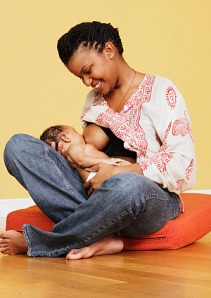I remember vividly the first time I held my baby with the intention of breastfeeding her.
I was a first time mother and I had mixed emotions, excited scared and confused.
I carefully placed the tiny head in my left palm and directed the tiny mouth to latch onto the breast.
The innocent being would not latch.
I rubbed the breast on her soft lips, she still did not budge.
Her eyes were wide open staring at me.
I looked at the nurse my eyes pleading for help.
She squeezed the baby’s cheeks.
For a moment I thought she was hurting my baby.
As soon as the tiny mouth opened, I quickly put the breast into the mouth.
My baby looked at me and started suckling.
I was overjoyed.

You see I had been scared that she would refuse my milk, not for any reason, but I was just scared.
It might sound very petty but most first time mothers experience this.
We all want our babies to breastfeed.
The support I got from the nurse was very crucial.
She came to check on me often to make sure that I was doing well and my baby was breastfeeding.
No one should assume that because you are pregnant, you know how to breastfeed.
That is why the new brochure led by World Health Organisation and UNICEF and developed jointly by Nutrition and Maternal, Newborn and Child Health colleagues on the crucial link between breastfeeding and newborn survival and health clearly emphasizes that the ten steps to successful breastfeeding include the training of doctors, nurses and midwives and community health workers to provide counseling and support within an hour of childbirth.
It is the early initiation to breastfeeding that is key to the survival of our newborn babies. However statistics show that less than 50 percent of newborns are breastfed in the first hour of life
We have had so many times that it helps us in bonding with our offspring.
Is that all? NO.
Breastfeeding is a winning goal that saves lives.
Initiating breastfeeding in the first hour of life lays the foundation for optimal breastfeeding which consists of feeding only breastfeeding (not even water) until a child is six months old and continued breastfeeding along with safe and age appropriate complementary food up to two years or beyond.
And why is it so important that this is followed?
Studies show that a newborn first absorbs colostrum (first milk) that is rich in nutrients and antibodies.
Before we go any further let me debunk a very popular myth I grew up hearing.
Pregnant women are told that when you are breastfeeding for the first time squeeze out the milk on a towel or onto the ground.
“Mukaka iwowo imvura mvura haunakire mwana” (The first milk is too watery and it’s not tasty for the baby).
However the FACT is that that the “first milk is all the baby needs in the first few days of life!”
Feeding that milk will also help the mother to produce more breast milk.
Have you ever wondered why when your baby is not well health care providers tell you to continue breastfeeding the baby at all times?
It’s not only because the baby is hungry but because the milk has antibodies.
When you breastfeed your baby within an hour of birth you also protect yourself your health and reduce the risk of post partum hemorrhage.
Optimal breastfeeding of infants under two years of age has the greatest potential impact on child survival of all preventive interventions, with the potential to prevent over 800,000 deaths (13 per cent of all deaths) in children under five in the developing world (Lancet 2013).
UNICEF says breastfed children have at least six times greater chance of survival in the early months than non-breastfed children.
An exclusively breastfed child is 14 times less likely to die in the first six months than a non-breastfed child, and breastfeeding drastically reduces deaths from acute respiratory infection and diarrhea, two major child killers (Lancet 2008).
“Virtually every mother can breastfeed, if given appropriate support, advice and encouragement, as well as practical assistance to resolve any problems. Studies have shown that early skin to skin contact between mothers and babies, frequent and unrestricted breast feeding to ensure continued production of milk and help with positioning and attaching the baby increase the chances of breast feeding being successful.”
Misinformation and lack of early support can keep mothers from breastfeeding and expose newborns to infections and inadequate nutrition.
Some breastfeeding mothers may need help to improve the way the baby takes the breast into the mouth to ensure good attachment so the baby can suckle effectively.
If the baby does not latch well it may result in the mother’s nipples cracking.
The nipples will be very painful and this may cause discomfort when breastfeeding.
An infection might also come about.
A visit to the nearest health care provider is essential.
Babies need more opportunities to breastfeed. They should breastfeed “on demand” day and night at least eight times during a 24 hour period.
A baby should be allowed to breastfeed until he or she releases the breast and looks away satisfied and sleepy. It shows that the baby has had all they want from the breast and can be offered the other breast and may or may not want it.
For working mothers who travel a lot, you can continue to breastfeed your child when you return.
You should breastfeed as often as possible when you are with your baby and express your breast milk and dispose of it when you are apart.
After six months of age when babies begin to eat foods, breastfeeding should continue for up to two years because it is an important source of nutrition, energy and protection from illnesses.
Enjoy the rest of the World Breastfeeding Week!
Get in touch with me on the following:
Email-audiciouss@gmail.com
Facebook Health Talk with Melody
Twitter @healthtalkwithmelo
